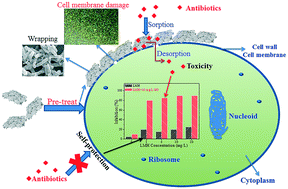Impact of graphene oxide on the antibacterial activity of antibiotics against bacteria†
Abstract
Graphene oxide (GO) can affect the antibacterial ability of antibiotics by serving as an antibiotic carrier. However, the mechanisms for the antibacterial activity of a combination of GO and antibiotics are not known. In this study, we examined the effect of GO on the antibacterial activity of three antibiotics (i.e., lincomycin hydrochloride (LMH), chloramphenicol (CPC) and gentamycin sulfate (GMS)) against Gram-negative Escherichia coli bacteria (e.g. E. coli) and Gram-positive Staphylococcus aureus bacteria (e.g. S. aureus). GO will coat on the bacteria and cause cell membrane damage, assisting growth inhibition of bacteria, with a stronger effect on S. aureus than E. coli. The inactivation of E. coli and S. aureus with bare GO is concentration- and time-dependent. The presence of GO increases or decreases the antibacterial ability of antibiotics, depending on the interaction of GO with the antibiotic, the interaction of GO with bacteria, and the sensitivity of bacteria to the antibiotic. The contact order of GO, the antibiotic and the bacterium has a notable effect on the combined antibacterial activity of antibiotics and GO. The pretreatment of GO with bacteria will increase the antibacterial ability of LMH and CPC significantly, while LMH and CPC show relatively low sensitivity to bacteria. The combination of GO and different antibiotics provides different extents of antibacterial efficiency toward microorganisms.



 Please wait while we load your content...
Please wait while we load your content...